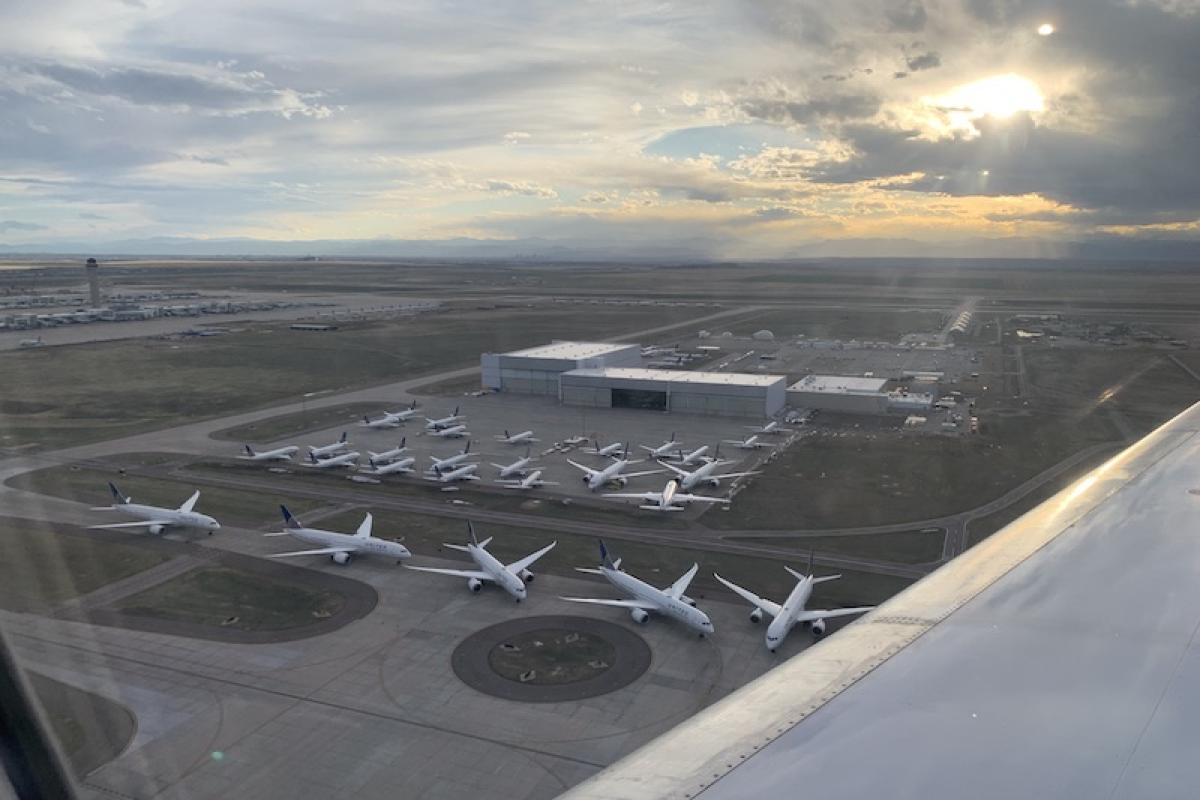Q&A: How Coronavirus Is Changing the Airline Industry

Parked planes at Denver International Airport
One of the industries hit hardest by the coronavirus pandemic is the aviation industry. Airlines face millions of dollars in losses, as hundreds of empty planes are grounded and parked on runways and as airports resemble ghost towns. Lowell Valencia-Miller is a teaching assistant professor and director of the master’s of science program in the Department of Management at the Daniels College of Business. One of his most notable entrepreneurial endeavors was helping launch Frontier Airlines in 1994. He shared his expertise via email with the DU Newsroom.
How will airlines recover from the economic loss triggered by the coronavirus, and how long will it take? Will the airline industry be changed for good?
We honestly do not know the answers to these questions. We, as a nation, have never been put into this type of situation before in modern times. The last time there was a pandemic that had this type of impact on our economy was the Spanish Flu of 1918, and at that time aviation was only 15 years old, given the first flight by the Wright brothers in 1903. We can make assumptions from the past that would indicate that it will take a proportionally longer time to fully recover than the amount of time the industry is all but shut down. We can use the shutdown of aviation immediately following the attacks of 9/11 as the basis for our assumptions. One thing that we do know is that based upon what happened after 9/11, the industry will go through changes. [What] we don’t know is will the changes be for the good or for the not so good.
After Sept. 11, 2001, the airline industry consolidated from nine major U.S. carriers down to just four. Do you think we will see another round of mergers?
If the past can help us determine what we might expect in the future, the events of Sept. 11 are a good benchmark to measure our efforts after this crisis. The 72 hours immediately after those horrific events left the aviation industry in disarray. Airline executives seeking information and guidance regularly joined conference calls with government officials. Unfortunately, no one had any immediate answers as to when and how the U.S. aviation industry would get back to flying. The only thing they knew was that there was a strong desire to get back to flying [because] aviation has played an important role in our nation’s economic growth.
Given the nature of the aviation industry, cash is king. The lifeblood for all airlines is the cash they generate in future bookings. Without future bookings, cash dries up, and the ability to operate flights is significantly impaired. Even with approval to resume flying on Sept. 14, many airline executives knew that future bookings would be a struggle, as travelers would be hesitant to get back on a flight until they felt comfortable. It is with this uncertainty in mind that many airlines implemented reductions in flight schedules, staff and salaries to conserve cash. Even with these moves, this was not enough to save most airlines from having to file bankruptcy or seek consolidation within the industry. Simply put, there were too many airlines with too many seats all vying for the small number of passengers who were forced to fly.
One step taken that delayed some of the eventual industry consolidation was the support given by the U.S. government in the form of the Air Transportation Safety and System Stabilization Act, signed into law on Sept. 22, 2001. This infusion of cash helped keep the airlines going, but it did not stop the furloughs, lay-offs and eventual mergers (Continental with United, Northwest with Delta, Air Tran with Southwest and America West with US Airways, [which] then merged with American Airlines).
Using the past to predict the future, it is assumed that after this pandemic crisis, some airlines will need either to file for bankruptcy or seek consolidation through a merger. The same scenario exists today that existed in 2001: too many airline seats with too few business travelers who will be forced to return to flying.
Some observers warn the $50 billion airline bailout from Congress won’t be enough to save the industry. Others argue that the airlines don’t deserve a bailout. What are your thoughts?
The Coronavirus Aid, Relief, and Economic Security Act (or the CARES Act) provides for financial assistance to those U.S. air carries that sign up for the aid with the U.S. Department of the Treasury. Though there are questions as to the details involving the purchase of shares of stock or warrants in the airlines (similar to the auto bailout in 2008 through the Troubled Asset Relief Program or TARP), the financial assistance will enable airlines to publish and operate schedules that will meet the diminished domestic demand due to consumer uncertainty once the social distancing and travel restrictions are lifted. The big question is when will these social distancing and travel restriction be lifted.
Because airlines rely on future bookings to generate the cash to continue operating their flight schedules, the question will be whether the financial assistance will be enough to maintain their operations until passenger traffic returns to “normal.” The next big question is: What will normal look like post coronavirus? We know that after 9/11, the creation of the Transportation Security Administration (TSA) was required to improve the safety of flying [in the face of terrorism]. Will some sort of health monitoring and testing be required for all travelers before boarding a flight? Without a program or agency to screen the health of travelers boarding flights, anything the airlines might do to revive the industry would be insufficient to alleviate the overriding uncertainty that this health crisis might occur again.
What do these potential changes mean for passengers?
Just like all the other changes over the years to improve aviation safety, the airline industry will once again work collaboratively with government officials to do the same after this pandemic crisis. As you might remember, in January 1973 [in the aftermath of a spate of hijackings], all passengers and visitors had to be screened before proceeding to the departure gates of all U.S. airports. It was a change, but we as travelers saw a dramatic decrease in attempted hijackings as a result.
After the TSA was formed and moved to the Department of Homeland Security in March 2003, this change transferred the responsibility of security from the airlines to the U.S. government. Again, we as travelers adapted to these changes and, more importantly, have not seen an act of terrorism involving a U.S. aircraft since 9/11. It is with this idea of eliminating potential threats to all passengers that changes will be proposed by the U.S. government in partnership with the aviation industry. The question is: What will that change look like, and how will it impact what we do before we get to the airport or what we will have to do once we get there? Whatever it will be, it will have the impact of increasing our safety.
Airline pilots just saw a wave of furloughs and now hiring freezes. How will this impact the pilot shortage?
It is safe to say that there will be pilots looking for positions once airlines have recalled their own pilots who have taken voluntary time-off without pay or been furloughed. The dramatic need for pilots due to the expected growth in Asia and the Middle East will now be delayed for the foreseeable future.
With many veteran pilots reaching the age of mandatory retirement and with the dramatic growth of commercial aviation in Asia and the Middle East, the pilot shortage was a real threat to the future growth of airlines worldwide. It was predicted that in the next 10 years, China would have become the world’s largest domestic aviation market. Though not growing as rapidly as China, according to a Federal Aviation Administration report, aviation in the United States was expected to grow roughly 2% domestically and 3.5% internationally each year through 2039. This growth would have [increased] the number of pilots needed by U.S. airlines to meet this demand.
The larger U.S. carriers have been developing pipelines of trained pilots from regional airlines. In addition, they have also been setting up their own training academies to augment the experienced pilots they had been getting from the regional airlines. Then, along came COVID-19.
As a result of the pandemic, it is estimated that airlines have reduced the number of operating passenger flights from between 40% and 90% domestically and internationally. [Given that], some airlines have asked [pilots to take] voluntary time off without pay through May. Other creative solutions include offering line-sharing, so that two employees could share a line of flying so that at least [they] were getting some pay if they were flying. Unfortunately, some of the smaller regional airlines do not have the financial resources to simply reduce flying and ask for voluntary time off without pay. As a result, two smaller regional airlines have already stopped operations due to the coronavirus.









